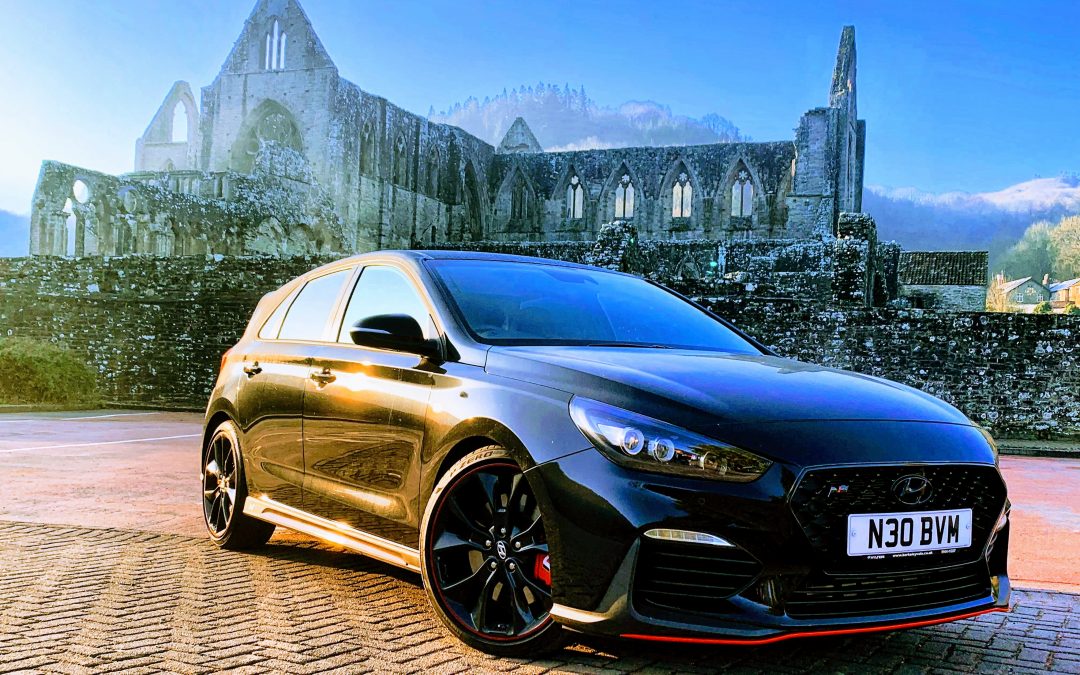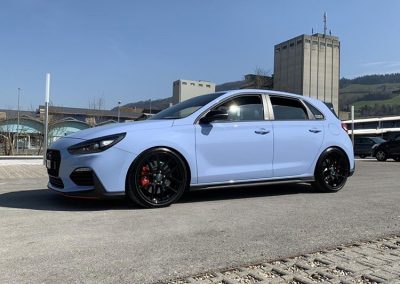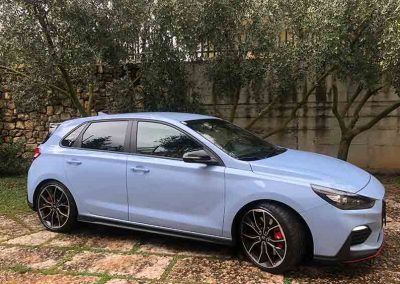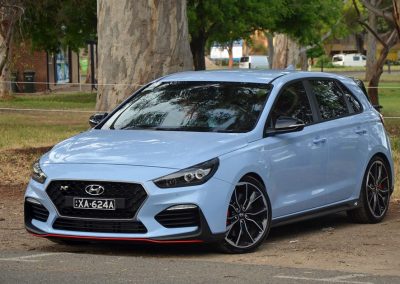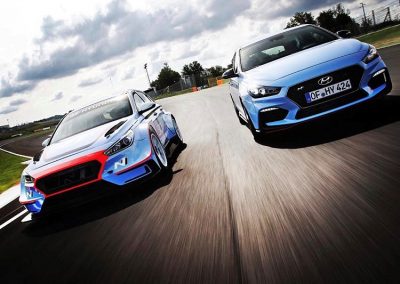Life with the I30N
Hyundai’s first proper hot hatchback arrived with a reasonable amount of hype behind it. After nine months of running one in the Top Gear garage, the i30N hasn’t just lived up to those high expectations, but surpassed them. It’s an extraordinary achievement to cause such an upset first time out, not least when the hot hatch market is in its most exciting ever position. The i30N had to impress against strong rivals from Ford, Honda, Peugeot, Renault, Seat and VW – among many others – but that’s exactly what it’s done. Our i30N Performance arrived with a mere 800 miles on the clock. Naturally we specced the higher-powered, more-focused i30N Performance version. For £3,000 more – or an extra £10 each month if you’re leasing – you get bigger, 19in wheels on stickier Pirelli P Zero tyres, a limited-slip differential, a riotous sports exhaust and another 25bhp, taking total output to 271bhp.
You also get the option of Performance Blue paint, a must if you want your car to look as vibrant as ours against a typically gloomy British backdrop. Total bill? Quite a lot for a Hyundai, at £28,580, but very competitive in hot hatch terms.
All i30Ns get a pair of fantastic sports seats up front. Most hot hatch makers are really nailing their seats at the moment, and Hyundai’s managed it without going to a big-name manufacturer like Recaro.
It made own-brand alternatives to keep the car’s list price low, but the seats hug exactly where you want them too and have never made me ache, even after some slightly exhausting 12-hour days behind the wheel. The driving position is great, too; not as low-slung as in a Civic Type R, but considerably better than the sitting-amongst-the-headlining Focus RS.
All i30Ns also get a manual gearbox, with a paddleshift auto appearing on future N products further down the line. You wouldn’t want it here; while not as delightfully taut as a Type R’s shift, Hyundai’s six-speed transmission is a joy to use and with a nice, gimmick-free knob that’s shaped properly.
You also get auto rev-matching, the car blipping the throttle to replicate heel-and-toe down changes. Evidencing the fact N’s engineers are proper petrolheads, it’s a function that turns on and off easily with a single button press. So if you want to try out your own skills, you can do so without navigating lots of clunky menus (take note, Honda).
Since March, our i30N’s covered, um, 16,000 miles. Quite impressive given my daily commute is only a 25-mile round trip. It’s fair to say the N’s been on some adventures, the first of which was a trip to its spiritual home to watch the Nürburgring 24 Hours.
The journey there revealed some chinks in the Hyundai’s armour. It’s tough to top 30mpg in the i30N, and a relatively small fuel tank means you’ll likely scrape 300 miles between fill ups unless you like playing chicken with the fuel light. Which I really don’t.
Mind, my attempts to nudge the 155mph limiter on the autobahn took a good chunk out of the fuel economy. The best effort was an indicated 140mph; above that, the i30N’s acceleration isn’t so rabid. Don’t say we can’t provide proper consumer advice.
A month later, the i30N and I returned to mainland Europe to follow Thierry Neuville’s i20 R5 around the Ypres rally.
Yet more great consumer advice: should you find yourself leaving a rally stage just as the roads it closed open back up, an i30N is a fine device in which to live out your rally fantasies, sports exhaust popping and crackling away like it’s an anti-lag system.
Alright, some real consumer advice now. This year saw something important happen: Renault Sport launched a brand new Megane RS. Given the outgoing car is one of the greatest hot hatchbacks ever – and one of the very best performance cars I’ve driven during my decade on the job – the new one arrived to high hopes.
High hopes it couldn’t quite meet, a new four-wheel-steer system complicating its dynamics while the rest of the car matured too much trying to battle the Golf GTI. The perfect chance for the vehemently old-school i30N to cause a bit of an upset, then, offering a simpler, easier to enjoy driving experience while costing about six grand less than the Megane, like-for-like.
Fantastic as the i30N is, though, it couldn’t quite dethrone our current hot hatch king, the Honda Civic Type R. Yet it’s easy to argue the Hyundai’s a better road car: being 45bhp down and forgoing the Type R’s wild aero package, it’ll never provide pub bragging rights, but it will allow you to use much more of its performance on any given B-road. Unless you’re a regular track-goer, it might be the better option of this pair.
Time for some more quibbles. The Hyundai’s turning circle is atrocious, so even the simplest of U-turns or car park manoeuvres quickly turn into a nine-point turn sound tracked by impatient heckles and beeps from everyone around. Lots of high-power front-wheel-drive cars have this affliction – the mk2 Focus RS was especially guilty – but the i30N seems to have had its manoeuvrability benchmarked on an oil tanker.
Oh, and see those lovely wheels? Look at how little tyre sidewall they’re wrapped in. I’ve yet to kerb any of them, but every time I parallel park or negotiate an inner-city width restrictor, my heartbeat trebles. Merely looking at this picture makes me tense up thinking about it.
The interior’s not especially glamorous – a bit of blue stitching on the wheel is all that lifts it on first impression – but the ergonomics and layout have been nailed, with Hyundai clearly wanting to mimic the sensible layout of Volkswagen’s interiors.
There are loads of wonderfully geeky touches, too, many of them nicked from BMW M cars (Hyundai N’s boss Albert Biermann was poached from Munich). So the rev limit is illuminated on the dial by orange and red lights, and it visibly moves as the engine warms up. You also get two driving mode selection buttons on the steering wheel, one of them being where you save your favourite settings, so they’re one quick prod away when you pull onto your favourite back road.
Technically, there are 1,944 possible combinations of how you set the engine, exhaust, suspension etc. In truth the system is much simpler to get your head around than such a silly figure suggests – you’re never going to pair the Eco engine with the Sport+ exhaust, after all.
My pick?
Sport for everything, except the steering (Normal) and the engine (Sport+). The stability control has a mid-way Sport setting, which is my pick most of the time. But on the right piece of road, you can turn it all the way off – and ‘off’ really does mean ‘off’ – to enjoy a surprisingly wild ride for a car with a five-year warranty. The i30N will do proper lift-off oversteer if you go looking for. it.
Some big changes, yet they serve to amplify the i30N’s existing traits rather than reinvent its character, which is what I admire most in tuner cars. There’s the same rambunctious attitude, just with added precision.
For the Top Gear Link and the complete website hit the button below.
@Wyss Performance Switzerland
From Italy
Courtesy of Giulia
i30N in the Park Australia

